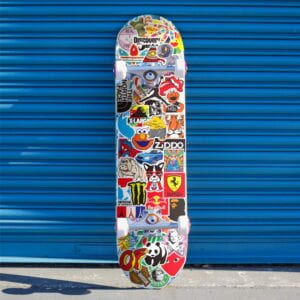For several decades now, skateboard stickers have been an inseparable element of street art and urban expression of the youths. In the times of rebellion and postmodern imagery of the new generation one could spot them wherever – on the sidewalks, skateboards, snowboards and surfboards. At the turn of the 1980s and 1990s, stickers served as both a part of the art movement and a means of advertising for underground clothing companies.

Tattooed Mom on South Street; Source: Street Art NYC
Going viral in the analogue world
In the analogue world, prior to the advent of the internet, comic book artists, often skilled in illustration, came up with an incredibly affordable way to reach a wide audience. They used paper with a little glue on one side as a mini canvas, and began spreading their art through the streets of California and other cities dominated by hip-hop and street culture fans. Artists massively printed their works on stickers, which they later placed in various corners of their cities. Some shared them with friends and asked for stickers to be placed in their cities, while others preferred to individually leave their artistic footprint wherever they went (Stick To It).

Beastie Boys by Eric Haze; Source: StickerArt
Visual artist, 14 Bolt, in the interview for the first episode of Alexis Deforges’s Stick To It, reflects that such popularization of art has greatly “cut the distance between you and the artists you admire”. 14 Bolt goes on to say that with this kind of collaboration aimed at bringing a fresh character to skate cities, he felt “part of the family, part of the community and part of the art.” Eric Haze, on the other hand, emphasizes how stickers and the hype around them facilitated the development of underground clothing companies. Distributing and handing out the stickers to the desired streetwear audience was an inexpensive way to bring the brand to the streets. People not only exchanged ideas and influenced local art, but also exchanged products and advertised newly created micro-companies.

Hip-hop logo by Eric Haze; Source: PlasticCircles
Layer of protection
While some companies only created and distributed stickers with their own logos, some developed visually intriguing illustrations that don’t necessarily focus on increasing brand recognition. Some designers just want skateboarders to feel one with the culture and in the center of the buzz. A deck full with stickers for a skateboarder serves as an identifier suggesting what kind of music someone listens to, what brands they like and support, and what type of person they are. In addition to the impressionistic value, the stickers are also quite functional. They are usually glued on the scratched decks, and the high quality, water resistant vinyl on which they tend to be printed can prevent further damage and extend the life of the deck by months, if not years (Surfertoday).

Stickers on a skateboard; Source: Desertcart
In the drawer of my desk back home, I still have stickers collected at Absolut Park in Flachauwinkl, Austria. It was in that winter that together with my older brothers I started collecting stickers (they actually used my sweet little girl charm to expand their collection!)
The Screaming hand
Perhaps the most recognizable graphic in the skateboarding community is “Screaming Hand”, designed by Jim Phillips in 1985. Shortly after its release, it became the official logo of Santa Cruz Skateboards, the world’s oldest skateboarding company, for which Jim had also designed the lettering. As a person who grew up in Santa Cruz spending his free time surfing, in his art, Jim has always tried to channel the surroundings into his sketches and drawings. The Screaming Hand serves as “a timeless skateboarding symbol that stuck through generations of old and new school skateboarders” (Surfertoday).

“Screaming Hand” designed by Jim Phillips in 1985; Source: AlfalfaStudio
It can be found everywhere in the world of skateboarding, it is very expressive, impactful and works well on its own – it does not need additional lettering, shapes or background (Studio Visit with Jim Phillips). One can spot it everywhere in the skateboarding world, it’s highly expressive, impactful and works well on its own – it doesn’t need extra lettering, shapes, backgrounds. It thus fulfils its sole purpose – it looks cool.

Santa Cruz’s vintage stickers; Source: NHSFunFactory
Stüssy
The late ‘80s and early’90s also brought a shift in the ideology of casual-wear. Stüssy, a brand founded by Southern California surfer Shawn Stüssy, grew organically out of youth movements and inadvertently revolutionized the apparel industry (Stüssy). Shawn used to shape his own boards for friends and locals and to promote his services decided to scribble his name on the boards. Stüssy later began selling t-shirts and shorts along with surfboards, and a bold graffiti-inspired hand-style signature became the company’s logo. By 1988, the brand had expanded to other locations in the US and Europe, joining the high-priced “California lifestyle” clothing market.
 Stüssy’s Collection; Source: MarieClaire
Stüssy’s Collection; Source: MarieClaire
Very intriguing. I like how you included the practical side of covering the bottom of the board with stickers as it makes the board last longer. However, as you have described, this is obviously not the main intent of the stickers. If you were to expand this in the future it would be cool to see how/where this expands across cultures, rather than just the American West Coast. Further, sticker culture took off past just skate culture and spread to covering water bottles, laptops, etc. with stickers. It would be interesting to dive into this. Overall, well done 🙂
Dear Megan, thank you for your feedback. There’s so much to talk about in sticker culture. Due to the time and word count constraints, I focused on a tiny part concerning West Coast and skateboarding. Feel free to explore other topics in your next blog entry!